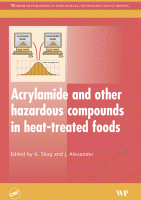Browse content
Table of contents
Actions for selected chapters
- Full text access
- Book chapterNo access
Appendix I - List of abbreviations of heterocyclic amines
Page 494 - Book chapterNo access
Appendix II - Molecular structures of heterocylic amines
Pages 495-498 - Book chapterNo access
Index
Pages 499-513
About the book
Description
Although the aim of cooking foods is to make them more appetizing and microbiologically safe, it is now known that cooking and food processing at high temperatures generate various kinds of toxic substances, such as heterocyclic amines and acrylamide, via the Maillard reaction. Summarising the latest research in this field, this important collection discusses both the formation of health-hazardous compounds during heat treatment of foods and practical methods to minimise their formation.
Part one analyses the formation of hazardous compounds in heat-treated foods such as meat, potatoes, cereal and coffee. Part two discusses the health risks posed by heat-induced toxicants. It includes chapters on bio-monitoring, exposure assessment and risk assessment, as well as chapters on the risks of specific compounds. The final part of the book is concerned with the key area of minimising the formation of harmful compounds in food products. This can be achieved by controlling processing conditions and modifying ingredients, among other methods.
With its distinguished editors and international team of contributors with unrivalled academic and industry experience, Acrylamide and other hazardous compounds in heat-treated foods, is invaluable for all those concerned with this crucial safety issue throughout the food industry.
Although the aim of cooking foods is to make them more appetizing and microbiologically safe, it is now known that cooking and food processing at high temperatures generate various kinds of toxic substances, such as heterocyclic amines and acrylamide, via the Maillard reaction. Summarising the latest research in this field, this important collection discusses both the formation of health-hazardous compounds during heat treatment of foods and practical methods to minimise their formation.
Part one analyses the formation of hazardous compounds in heat-treated foods such as meat, potatoes, cereal and coffee. Part two discusses the health risks posed by heat-induced toxicants. It includes chapters on bio-monitoring, exposure assessment and risk assessment, as well as chapters on the risks of specific compounds. The final part of the book is concerned with the key area of minimising the formation of harmful compounds in food products. This can be achieved by controlling processing conditions and modifying ingredients, among other methods.
With its distinguished editors and international team of contributors with unrivalled academic and industry experience, Acrylamide and other hazardous compounds in heat-treated foods, is invaluable for all those concerned with this crucial safety issue throughout the food industry.
Key Features
- Analyses the formation of health hazardous compounds during heat treatment of foods
- Discusses practical methods to minimise formation
- Distinguished editors and international team of contributors
- Analyses the formation of health hazardous compounds during heat treatment of foods
- Discusses practical methods to minimise formation
- Distinguished editors and international team of contributors
Details
ISBN
978-1-84569-011-3
Language
English
Published
2006
Copyright
Copyright © 2006 Woodhead Publishing Limited. All rights reserved.
Imprint
Woodhead Publishing
